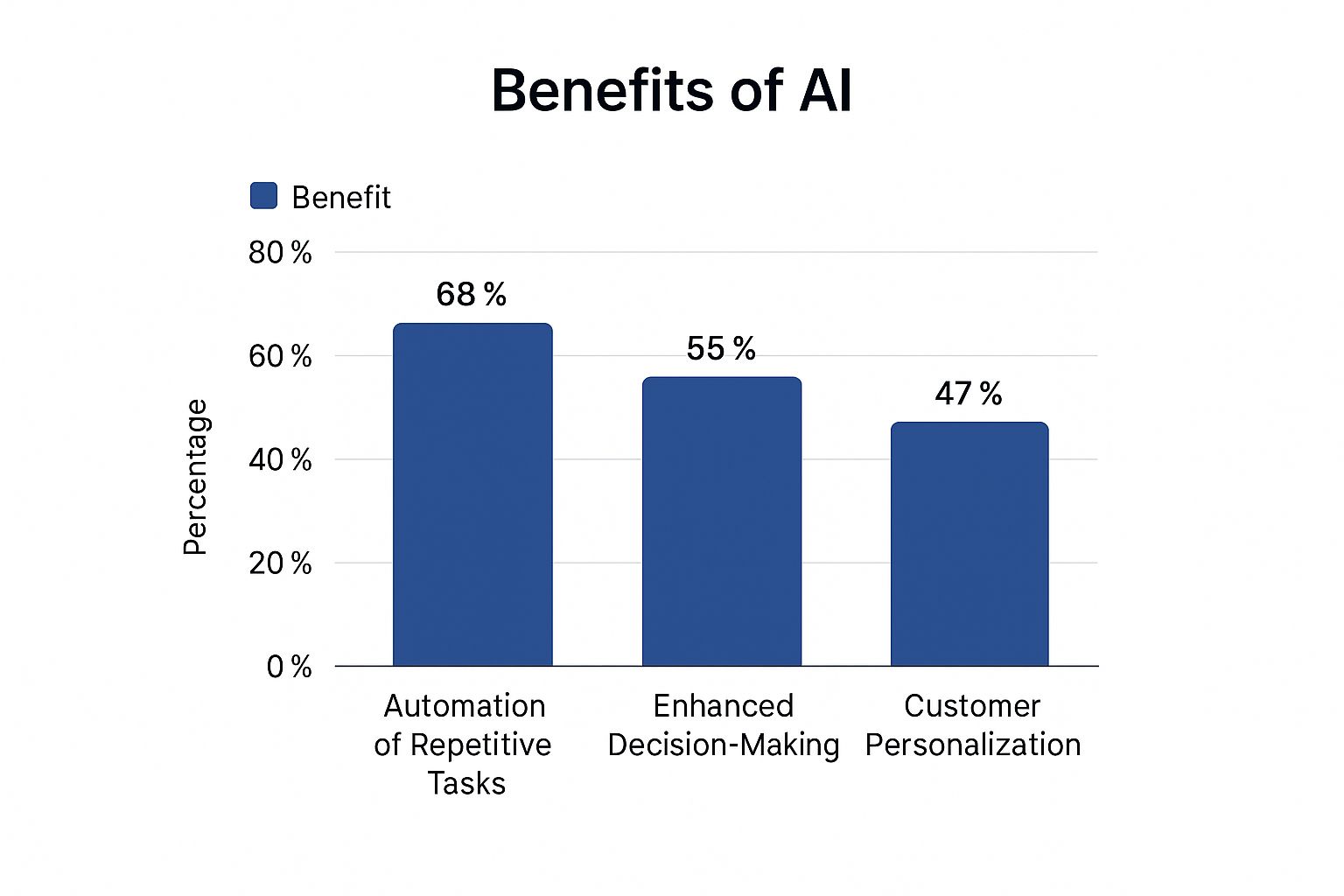The story of AI adoption in Canadian enterprises isn't a sudden explosion; it's more like a slow, steady burn.The story of AI adoption in Canadian enterprises isn't a sudden explosion; it's more like a slow, steady burn. While the buzz is undeniable, the reality on the ground is cautious and uneven. Some sectors are sprinting ahead, while many others are still lacing up their shoes at the starting line.
Mapping Canada's AI Adoption Landscape

To gain a genuine understanding of where AI is headed, you first need to grasp the current state of Canadian businesses. The picture is a mix of genuine progress and significant hesitation. Many companies have moved past the "what is AI?" phase and are dipping their toes in the water with pilot projects or small-scale deployments, usually aimed at tidying up internal processes.
These initial forays often target the less glamorous, but highly practical areas of the business, like back-end operations or customer support. Think of a company using an AI tool to sift through customer service chats to spot common issues, freeing up human agents for more complex problems. Or maybe it's a machine learning model that fine-tunes a supply chain to cut down on shipping delays.
These early, contained wins are absolutely vital. They build the confidence and the business case needed to get leadership on board for bigger, more ambitious projects down the road.
The Numbers Behind the Narrative
Recent data from the Canadian Survey on Business Conditions gives us a clear look at this slow but steady climb. The numbers tell a story of growing intent.
The table below offers a snapshot of where Canadian businesses stand, highlighting both the growing interest and the widespread caution that still defines the market.
|
Metric |
Percentage |
|---|---|
|
Businesses planning to adopt AI in the next year |
14.5% |
|
Businesses with no current plans to adopt AI |
66.7% |
|
Businesses are uncertain about their AI adoption plans |
19% |
These figures, detailed in these findings on Canadian business conditions, show a promising uptick in planned adoption, rising from 10.6% the previous year. Yet, the fact that two-thirds of businesses still have no plans for AI speaks volumes about the challenges that remain.
This gap between the keen early adopters and the hesitant majority is the defining feature of Canada's current AI landscape. It's less of a nationwide tidal wave and more a collection of calculated moves by forward-thinking organizations.
A Tale of Two Sectors
Dig a little deeper, and you’ll see the adoption rate is anything but uniform across the board. Some industries have a much bigger appetite for AI, creating a real patchwork of progress.
The front-runners are exactly who you might expect:
-
Financial Services: Canada's big banks are global leaders in this space. They're using AI for everything from spotting fraudulent transactions in real-time to offering personalized client services and managing risk.
-
Information and Technology: No surprises here. Tech companies are naturally at the forefront, building AI into their products, streamlining software development, and even creating content.
-
Telecommunications: Major telecom players are investing heavily in AI to keep their networks running smoothly, improve customer interactions with smart chatbots, and make their own internal operations more efficient.
On the other side of the coin, sectors like agriculture, construction, and smaller retail shops are moving much more slowly. For them, the barriers, like cost, complexity, and a shortage of people with the right skills, often seem too high. This contrast makes one thing clear: the AI journey is deeply tied to the unique needs, resources, and rules of each industry.
Why Canadian Businesses are Turning to AI
The buzz around AI adoption in Canadian enterprises is more than just hype. It’s a practical response to real-world business challenges. Smart companies are looking past the science fiction and seeing AI for what it is: a powerful tool to solve problems, boost efficiency, and get ahead.
It’s not about chasing the next big thing. It's about finding better ways to operate, day in and day out. Think about automating tedious tasks that drain your team's energy, digging into your data to find hidden opportunities, or creating customer experiences that feel genuinely personal. This is where the real value lies.
A retailer, for example, can use AI to forecast next season's best-sellers, cutting down on unsold stock. A financial services firm can spot market shifts in real-time, something that would take a human analyst days to piece together. These are the kinds of tangible wins that are getting Canadian leaders to invest seriously in AI.
The Core Drivers of AI Integration
When you peel back the layers, you find that the push for AI adoption circles three fundamental business needs. Each one tackles a core part of running a modern company, from how work gets done internally to how customers are treated.
The goal is always the same: to build a smarter, more agile, and more competitive organization.
The infographic below breaks down the top motivators for Canadian businesses, showing exactly where they expect to see the biggest impact.

It’s no surprise that automating repetitive work is the clear leader, with 68% of companies wanting to free up their people from monotonous tasks.
This focus on efficiency is changing how work gets done across the country. Many Canadian businesses are finding clever ways to make their operations leaner. For instance, discovering methods for streamlining business processes with AI in Excel is a game-changer for many, allowing them to cut down on manual data entry and boost productivity without needing a massive, complex software rollout.
Enhancing Decision-Making with Data
Beyond just doing things faster, AI is about doing them smarter. Canadian companies are collecting massive amounts of data from sales figures and supply chain movements, to customer feedback. AI is the key that unlocks the powerful insights buried inside all that information.
Instead of just relying on gut instinct or past performance, business leaders can now use predictive analytics to see what’s coming. This data-first approach helps de-risk big decisions and shine a light on new paths for growth.
Just think about the possibilities:
-
Financial Forecasting: AI can sift through market data, economic reports, and consumer trends to build financial models that are far more accurate than traditional methods.
-
Inventory Management: Machine learning can anticipate spikes and dips in demand, helping you keep just the right amount of product on hand; no more costly overstock or missed sales.
-
Strategic Planning: By analyzing the competitive landscape, AI can help you spot a gap in the market or a potential threat long before it becomes obvious.
This arms your entire team, from the front lines to the C-suite, with the evidence they need to make confident choices.
Creating Superior Customer Experiences
In today's market, personalization isn't a bonus; it's an expectation. Customers want to feel seen and understood, and AI makes it possible to deliver that tailored experience to every single person, every single time.
AI algorithms can look at a customer's entire journey, including their browsing habits, purchase history, and even their support tickets, to build a clear picture of who they are. This lets a business:
-
Recommend Relevant Products: Show customers things they’ll actually want to buy, which naturally leads to more sales.
-
Personalize Marketing: Send emails and ads that speak directly to an individual's interests, building a much stronger connection.
-
Anticipate Customer Needs: Solve a problem before it even happens or offer help at just the right moment.
By truly understanding the people they serve, Canadian companies can build the kind of loyalty that lasts. And in the end, that's what it’s all about.
Real-World AI in Action Across Canadian Industries

It’s easy to think of artificial intelligence as something abstract, a concept for the future. But right now, across Canada, businesses are putting AI to work on real, everyday problems. AI adoption in Canadian enterprises isn't about some universal solution; it's about smart, focused tools solving specific challenges and delivering real value.
From automating creative workflows to flagging suspicious bank transactions, the ways AI is being used are as diverse as Canada's economy. Looking at how different sectors are actually using these tools gives us a much clearer picture of what's possible.
And the progress is picking up speed. The latest numbers show 12.2% of Canadian businesses are now using AI, a huge jump from just 6.1% the year before. While this shows serious momentum, adoption isn't happening at the same pace everywhere. You can dive deeper into the numbers in the latest Statistics Canada report on AI use.
Leaders in Tech and Finance
Unsurprisingly, some industries are way ahead of the curve. The tech-savvy fields, like Information and Cultural Industries, along with Professional, Scientific, and Technical Services, are leading the pack, using AI to get ahead.
For any business swimming in text data like customer feedback or internal reports, getting a handle on Natural Language Processing (NLP) for Business is a game-changer. It's a technology that these leading sectors are already mastering.
Here’s what that looks like on the ground:
-
Information and Cultural Industries (20.9% adoption): Think of media giants using AI to figure out what you want to watch next or personalizing news feeds. It's also being used behind the scenes to help draft articles and scripts, speeding up the whole content creation process.
-
Professional, Scientific, and Technical Services (13.7% adoption): In this world, engineering and research firms are using machine learning to make sense of massive datasets. They can simulate project outcomes or automate mind-numbing reports, freeing up their brilliant human experts to focus on strategy instead of spreadsheets.
Securing the Financial Sector
The Finance and Insurance sector, with a 10.9% adoption rate, is a fantastic example of AI's power where the stakes are high. Canada's banks, known for being early movers, are using AI to make banking safer and more personal for all of us.
AI algorithms are the unsung heroes working 24/7, scanning thousands of transactions every second. They're looking for tiny anomalies that scream "fraud," protecting both the bank and its customers from financial headaches.
But it’s not just about security. AI is also changing how we interact with our banks. They’re using it to:
-
Offer Personalized Advice: AI can look at your financial habits and goals to suggest saving strategies or investment ideas that actually make sense for you.
-
Streamline Loan Approvals: Algorithms assess credit risk faster and more fairly than the old manual way, which means quicker answers for people who need loans.
-
Improve Customer Support: Those helpful chatbots that answer your basic questions instantly? That's AI at work, freeing up human agents to tackle the really tricky problems.
The table below gives a snapshot of how different sectors are adopting AI, showing a clear divide between the early adopters and those still exploring its potential.
AI Adoption Rates Across Key Canadian Sectors
|
Industry Sector |
AI Adoption Rate (%) |
|---|---|
|
Information and Cultural Industries |
20.9% |
|
Professional, Scientific, and Technical Services |
13.7% |
|
Finance and Insurance |
10.9% |
|
Wholesale Trade |
8.4% |
|
Retail Trade |
7.5% |
|
Manufacturing |
6.6% |
|
Construction |
3.5% |
|
Agriculture, Forestry, Fishing and Hunting |
3.0% |
This data highlights the sectors that are setting the pace. For industries like construction and agriculture, the numbers suggest a huge opportunity for growth and innovation that is just beginning.
Emerging AI Applications in Other Sectors
While some industries are racing ahead, others, like agriculture and construction, are being more deliberate. That's not a bad thing; the potential impact in these foundational sectors is massive, and we’re starting to see applications that could solve some age-old problems.
In agriculture, AI-powered drones are flying over fields to monitor crop health, helping farmers use water more efficiently and predict their harvest with incredible accuracy. This isn't just about efficiency, but sustainable farming.
The same story is unfolding in healthcare. From analyzing medical scans with a level of detail that surpasses the human eye to predicting which patients might be at risk for certain conditions, AI is poised to make a real difference. The benefits of AI in Canadian health care are compelling, promising improvements from the back office to the patient's bedside.
As AI becomes more accessible, we’ll see this kind of innovation pop up in every corner of the Canadian economy. The real trick is for each business to figure out its unique challenges and ask, "How can AI help us solve this?" That’s how a powerful technology becomes a genuine business advantage.
Getting Past the Hurdles: Overcoming Key Barriers to AI Adoption
While the promise of AI is exciting, the road to actually using it isn't always smooth. Many Canadian businesses find themselves hitting significant roadblocks on their AI journey. These aren't just small bumps; they're real challenges that can stop an initiative in its tracks before it even gets off the ground.
The first step is to see these barriers for what they are. Instead of treating them like deal-breakers, smart leaders see them as strategic problems that need solving. For most Canadian companies, the obstacles boil down to three things: a shortage of people with the right skills, the high upfront cost, and very real worries about data security and privacy.
Tackling these head-on with a clear plan is what separates the companies that succeed from those that get stuck.
Addressing the AI Skills Gap
Let's be blunt: finding people who genuinely understand machine learning, data science, and AI engineering is tough. This talent shortage is one of the biggest hurdles for AI adoption in Canadian enterprises. These experts are wanted everywhere, which makes it hard for many Canadian companies, especially smaller ones, to attract and keep them.
But the answer isn't just about trying to outbid everyone for a handful of experts. A much more practical and long-lasting strategy is to build that talent right within your own walls.
-
Upskill Your Current Workforce: Look for people on your team who already have a knack for analytics or technology. Give them targeted training in AI and data fundamentals. This not only builds up your internal know-how but also shows your team you’re invested in their growth.
-
Partner with Educational Institutions: Team up with Canadian universities and colleges. Co-op programs and joint research projects can create a direct pipeline of new talent that’s already familiar with the kinds of problems your business faces.
-
Embrace Low-Code and No-Code AI Platforms: The latest AI tools are becoming much easier to use. Many platforms now allow teams without deep programming skills to build and roll out effective AI models for specific tasks.
By investing in your own people, you create a culture of learning and build an AI-ready workforce from the inside out.
Managing the Financial Investment
The sticker shock of AI is another major roadblock. The costs for specialized software, powerful computers, and six-figure salaries can feel overwhelming. It's a hard sell to ask for a massive upfront investment in something that doesn't have a guaranteed return on investment (ROI).
The trick is to stop thinking of it as a "cost" and start seeing it as an "investment." Instead of trying to boil the ocean with a massive, company-wide overhaul, begin with a small, focused pilot project. Pick one specific, high-impact business problem and solve it.
This approach keeps the initial risk low and lets you prove the value of AI quickly. For instance, you could implement an AI chatbot to handle common customer questions. This frees up your human agents to deal with more complicated issues. The time and money you save on that one project can make a powerful case for your next AI initiative.
Navigating Data Security and Privacy
In a world where everyone is (rightfully) concerned about data, security, and privacy are absolute must-haves. Using sensitive customer or company data to train AI models raises valid questions about legal compliance, potential breaches, and ethics. This is doubly true for regulated industries like finance and healthcare.
Putting a solid data governance framework in place is essential. This isn't just an IT checklist; it's a core business strategy.
-
Establish Clear Data Policies: Spell out exactly what data can be used, who gets to see it, and why. Make sure everything lines up with Canadian privacy laws like PIPEDA.
-
Invest in Secure Infrastructure: Whether your data is stored on-site or in the cloud, it needs to be locked down tight against any unauthorized access.
-
Prioritize Transparency: Be upfront with your customers and partners. Tell them how you're using their data to power your AI systems.
Facing these concerns directly builds trust and ensures your move into AI is both responsible and compliant. For fields like healthcare, getting this right is non-negotiable, a topic explored in guides on AI's role in Canadian healthcare data privacy. By turning these roadblocks into a strategic action plan, Canadian enterprises can move forward with confidence.
Navigating the Rise of Shadow AI
While many Canadian enterprises are meticulously mapping out their official AI strategies, a powerful, unofficial movement is already taking shape within their own walls. Employees, always looking for a better way to work, aren't waiting for a formal green light. They're jumping in, using unapproved, consumer-grade AI tools to get their jobs done faster and smarter. This is Shadow AI.
Think of your company's official IT setup as a well-maintained highway. It’s safe, compliant, and every vehicle is accounted for. Shadow AI is like your team taking unmarked shortcuts through the woods. They might get where they're going quicker, but they're bypassing all the safety checks and creating some serious risks along the way.
And this isn't just a few tech-savvy employees experimenting in a corner. It’s a widespread trend. Recent research uncovered a major disconnect: a staggering 79% of Canadian full-time office workers are using AI on the job, but only a quarter of them are using the enterprise-grade solutions their company actually provides. You can learn more about how Canadian workers are outpacing their employers in AI adoption in this IBM study.
Understanding the Risks of Unchecked AI Use
The quiet rise of Shadow AI presents a tricky challenge for Canadian business leaders. On one hand, it shows you have a team that's hungry to innovate. On the other hand, it opens up the business to some serious operational and security holes. When employees plug company data into personal AI apps, the organization loses control over its most valuable asset.
The potential fallout is both significant and varied:
-
Data Leaks and Security Breaches: Feeding sensitive company information, such as client lists, financial projections, or strategic plans, into a public AI model can lead to that data being exposed without anyone even realizing it.
-
Compliance Violations: For industries governed by strict data privacy laws like PIPEDA, using unvetted AI tools can result in hefty legal and financial penalties.
-
Inconsistent and Inaccurate Outputs: Consumer-grade AI tools often lack the reliability needed for business-critical tasks. This can lead to flawed decisions based on faulty information.
-
Lack of Oversight and Governance: With no central system, it's impossible to know how AI is being used, what data is being shared, or if the outputs meet company standards.
These aren't just theoretical worries. A single employee pasting a confidential internal memo into a public chatbot could have lasting consequences for the entire enterprise.
From Problem to Opportunity
It’s tempting to see Shadow AI as a problem to be stamped out with strict rules. But a much smarter approach is to see it for what it is: a clear signal of unmet needs. Your people aren't trying to cause trouble; they’re actively looking for ways to do their jobs better.
The surge in Shadow AI isn't a failure of compliance; it's a cry for innovation. It tells leaders exactly where the demand for smarter, more efficient tools lies within their organization.
Instead of cracking down, the real opportunity here is to guide this energy. This grassroots adoption provides invaluable insight into which tasks are screaming for AI-powered improvement. It points a spotlight on the friction in current workflows and shows a clear desire for the benefits that AI adoption in Canadian enterprises can deliver. Plus, with 46% of employees saying they'd consider leaving their job for one that uses AI more effectively, this has quickly become a talent retention issue.
Creating a Culture of Responsible Innovation
The best way to handle Shadow AI is to bring it out of the shadows. This means creating a framework that encourages people to experiment while still maintaining security and control. The goal is to build a bridge between your team's enthusiasm and the company's overarching strategy.
Here are a few actionable steps to get started:
-
Develop a Clear AI Usage Policy: Don’t just say "no." Create a straightforward policy that outlines which tools are approved, what kinds of data can be used, and the ground rules for responsible use.
-
Educate and Train Your Team: Host workshops and share resources that teach employees about both the incredible potential and the hidden pitfalls of AI. An informed team is your best line of defence against accidental data leaks.
-
Provide Vetted, Enterprise-Grade Alternatives: If you don't want your team using consumer tools, give them powerful, secure alternatives. Invest in enterprise-level AI platforms that meet your security standards and actually help them do their jobs.
-
Establish a Sandbox for Experimentation: Create a safe, controlled environment where teams can test-drive new AI tools using non-sensitive data. This fosters innovation without putting the company at risk.
By constructively channelling this grassroots energy, Canadian enterprises can turn Shadow AI from a hidden risk into a powerful catalyst for growth and a genuine competitive advantage.
Your Strategic Roadmap for AI Implementation

Jumping into AI without a clear plan is a recipe for expensive mistakes. For AI adoption in Canadian enterprises to truly succeed, it needs to be less about chasing shiny new technology and more about thoughtful, deliberate strategy. The goal is to connect every AI initiative directly to a real business outcome.
Think of it as a series of well-defined stages, not a single, risky leap. Each step builds on the last, letting you gather momentum and minimize risk along the way. This approach takes the guesswork out of implementation and gives you the confidence to move forward.
Step 1: Identify Business Problems First
One of the most common pitfalls is adopting AI just for the sake of it. The first, and most important, step is to look inward. What's a specific, high-value business challenge that AI could genuinely help solve?
Instead of asking, "How can we use AI?", frame the question differently: "Where is our biggest operational bottleneck?" or "What's costing us the most time and money?"
Look for pain points in areas like:
-
Repetitive administrative tasks that tie up your best people.
-
Common customer service questions follow predictable scripts.
-
Supply chain snags that cause costly delays or stock issues.
When you tie an AI project to a tangible problem, you're building a business case from day one.
Step 2: Conduct a Data Readiness Audit
AI runs on data. Simple as that. Before you can build anything meaningful, you have to get a clear picture of the quality, quantity, and accessibility of your data. Think of it like checking your pantry before starting a complicated recipe. You need to know what ingredients you have on hand.
This audit isn't just a technical exercise. It answers critical questions:
-
Data Quality: Is our data clean, accurate, and consistent enough to trust?
-
Data Accessibility: Can our systems actually get to the data, or is it locked away in different silos?
-
Data Volume: Do we have enough of the right kind of data to train a reliable model?
A thorough audit prevents you from building an ambitious AI project on a shaky foundation. It shows you what you have, what you're missing, and what it will take to close that gap.
Step 3: Start with a Focused Pilot Project
Rather than trying to boil the ocean with a massive, company-wide overhaul, start small. A focused pilot project lets you test your ideas, learn quickly, and show some early wins without a huge upfront investment.
A good pilot project is:
-
Specific: It targets the single business problem you identified in step one.
-
Measurable: Define what success looks like before you start. Maybe it's a 15% reduction in customer response times or a 10% decrease in certain operational costs.
-
Time-bound: Give it a clear timeline to keep everyone focused and to evaluate the results efficiently.
A successful pilot acts as a powerful proof-of-concept. It makes getting buy-in and resources for bigger projects so much easier. A solid plan is key here, and a good technology roadmap template can provide the structure you need.
Step 4: Build or Partner for Expertise
Once you have a clear goal and a proven concept, you need the right people to make it happen. For Canadian companies, this usually comes down to two choices: building your own in-house team or partnering with external experts. Building internally gives you long-term control, but partnering provides instant access to specialized skills without the long-term overhead.
Step 5: Scale and Govern Responsibly
With a successful pilot under your belt, it's time to think bigger. The final step is to scale the solution, methodically expanding it to other departments or business units. But as you grow, solid governance becomes essential.
This means creating clear policies around data privacy, the ethical use of AI, and ongoing monitoring to ensure your models remain fair and accurate. It’s how you ensure your AI journey is not just effective, but also responsible and built to last.
Your AI Questions, Answered
Jumping into the world of AI can feel overwhelming, and it’s natural for Canadian business leaders to have questions. You need clear answers, not just tech jargon, to figure out what's right for your company. Let's tackle some of the most common questions I hear from enterprises looking to get started.
Getting these fundamentals right is the key to moving forward with confidence and making smart investments from day one.
What’s the Real Cost of an AI Project for a Canadian Business?
That’s a bit like asking, "How much does a vehicle cost?" The answer really depends on what you need it to do.
You could start with an off-the-shelf AI software subscription, which is like getting a reliable company car. Think of tools for marketing automation or a customer service chatbot. These are often affordable, get you up and running quickly, and solve a specific, immediate problem with a predictable monthly fee.
On the other hand, building a completely custom machine learning model from scratch is more like commissioning a specialized transport truck. It’s a major investment in data scientists, infrastructure, and a lot of development time. For most businesses, this isn't the place to start.
The smartest AI strategies don't begin with a blank cheque. They start with a focused, budget-conscious pilot project designed to solve one specific problem and demonstrate clear business value.
My advice is always to start small. Pick one area, set a clear budget for a pilot project, and prove the return on investment. This methodical approach makes every dollar count and builds a strong case for expanding your efforts later on.
Where Should My Company Even Begin with AI?
The first step has nothing to do with technology. It’s all about your business strategy. Before you look at a single piece of software, you have to pinpoint a specific, high-value problem that you believe AI can help solve. One of the biggest mistakes I see is companies adopting AI just for the sake of it.
Start by asking the right questions inside your organization:
-
Where are our teams getting bogged down in repetitive, manual work?
-
What’s one business decision we could make better if we only had the right data?
-
Where do our customers experience the most friction or frustration?
When you start with a clear "why," your investment is automatically tied to a real business goal, whether that's cutting operational costs, making customers happier, or finding a new way to grow revenue. This problem-first mindset is the absolute foundation of any successful AI initiative.
Do We Really Need to Hire a Team of Data Scientists?
Not necessarily, especially in the beginning. While in-house data scientists are crucial for building sophisticated, custom AI models, the game has changed. Today, a huge number of powerful AI tools are available as user-friendly software that doesn't require a PhD to operate.
For most small and medium-sized Canadian businesses, exploring these "off-the-shelf" solutions is the most practical first step. These platforms do the heavy lifting in the background, letting your existing team focus on using the AI's insights to make better decisions. You can always bring on specialized talent down the road as your AI strategy becomes more ambitious.
At Cleffex Digital Ltd, we guide Canadian businesses through their AI journey with practical software solutions that deliver real results. We specialize in turning complex challenges into growth opportunities. Discover how our tailored technology services can accelerate your AI adoption by visiting us at https://www.cleffex.com.








